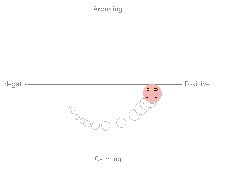Aktuelle Version vom 9. November 2022, 14:47 Uhr
Information zur Nachricht (bearbeiten ) Zu dieser Nachricht ist keine Dokumentation vorhanden.
Sofern du weißt, wo und in welchem Zusammenhang sie genutzt wird, kannst du anderen Übersetzern bei ihrer Arbeit helfen, indem du eine Dokumentation hinzufügst.
Nachricht im Original (Bisherige "continuous response" - Systeme )
=== EMuJoy ===
=== EMuJoy ===
[[Datei:EMuJoy1.jpg|mini|Abbildung 3.4: EMuJoy (Screenshot der Website http://musicweb.hmt-hannover.de/emujoy/)]]
EMuJoy ist die Abkürzung für das Interface ''Emotion measurement while listening to Music using a Joystick''. Die Software wurde 2007 von Frederik Nagel entwickelt und ist eine Weiterentwicklung des ESL. EMuJoy bietet die Möglichkeit, sowohl akustische, als auch visuelle Stimuli oder beides gleichzeitig zu verwenden. Bilder können in einer Slideshow mit je einer bestimmten Zeit, mit oder ohne Pausen dazwischen gezeigt werden. Bei Filmen können Bild und Ton auch getrennt gezeigt werden (Nagel 2007, S. 35f.). Der 2DES nimmt den gesamten Bildschirm ein, kann mit Joystick oder Maus bedient werden und bietet als optionale Visualisierung einen Wurm wie das Feeltrace. Statt der Visualisierung mit Farben gibt hier ein an Stelle des Mauszeigers befindlicher Smiley, der seinen Gesichtsausdruck der Position im Koordinatensystem anpasst, Userfeedback. Entlang der Valenz-Achse verändert sich der Mundwinkel und die Augengröße steigt mit zunehmender Aktivität. Per Mausklick werden zusätzlich Chills erfasst (Kopiez et al. 2011, S. 138-141). Weitere Vorteile von EMuJoy gegenüber den Vorgängern sind Plattformunabhängigkeit, da das Programm auf Java-Basis läuft, und Steuerung via Internet, sodass die Testpersonen zu Hause vor ihrem eigenen Computer an Untersuchunngen teilnehmen können. Außerdem gibt es eine Remote-Steuerung, sodass Starten, Stoppen sowie Aussuchen der Stimuli während des Versuchsverlaufs ermöglicht wird (Nagel 2007, S. 33f.). Nagel verwendet eine Sampling-Rate von 1/50ms, sodass die Daten bis 10 Hz ausgewertet werden können. Eine hohe Sampling-Rate ist vorteilhaft für die Synchronisation von Stimulus und den aufgezeichneten Daten. Man könnte meinen, da sich Emotionen weit langsamer ändern, sei eine so hohe Abtastrate unnötig, aber dennoch können die Selbstauskünfte sich sehr schnell ändern und man könnte wertvolle Daten verlieren, z. B. den schnellen Weg von der einen zur anderen Ecke (Nagel 2007, S. 32f.). Übersetzung === EMuJoy === EMuJoy EMuJoy is the abbreviation for the interface Emotion measurement while listening to Music using a Joystick . The software was developed in 2007 by Frederik Nagel and is a further development of the ESL. EMuJoy offers the possibility to use both acoustic and visual stimuli or both at the same time. Pictures can be shown in a slideshow with a certain time each, with or without pauses in between. For movies, images and sound can also be shown separately (Nagel 2007, p. 35f.). The 2DES takes up the whole screen, can be operated with joystick or mouse and offers a worm like the Feeltrace as optional visualization. Instead of the visualization with colors, a smiley in place of the mouse pointer, which adjusts its facial expression to the position in the coordinate system, provides user feedback. Along the valence axis, the corner of the mouth changes and the eye size increases with increasing activity. Chills are additionally captured via mouse click (Kopiez et al. 2011, pp. 138-141). Further advantages of EMuJoy compared to its predecessors are platform independence, since the program is Java-based, and control via the Internet, so that test subjects can participate in examinations at home in front of their own computers. In addition, there is a remote control, so that starting, stopping as well as selecting the stimuli is made possible during the course of the experiment (Nagel 2007, p. 33f.). Nagel uses a sampling rate of 1/50ms, so that the data can be evaluated up to 10 Hz. A high sampling rate is advantageous for the synchronization of stimulus and the recorded data. One might think that since emotions change far more slowly, such a high sampling rate would be unnecessary, but nevertheless, self-reports can change very quickly and one might lose valuable data, e.g., the fast path from one corner to the other (Nagel 2007, p. 32f.).
